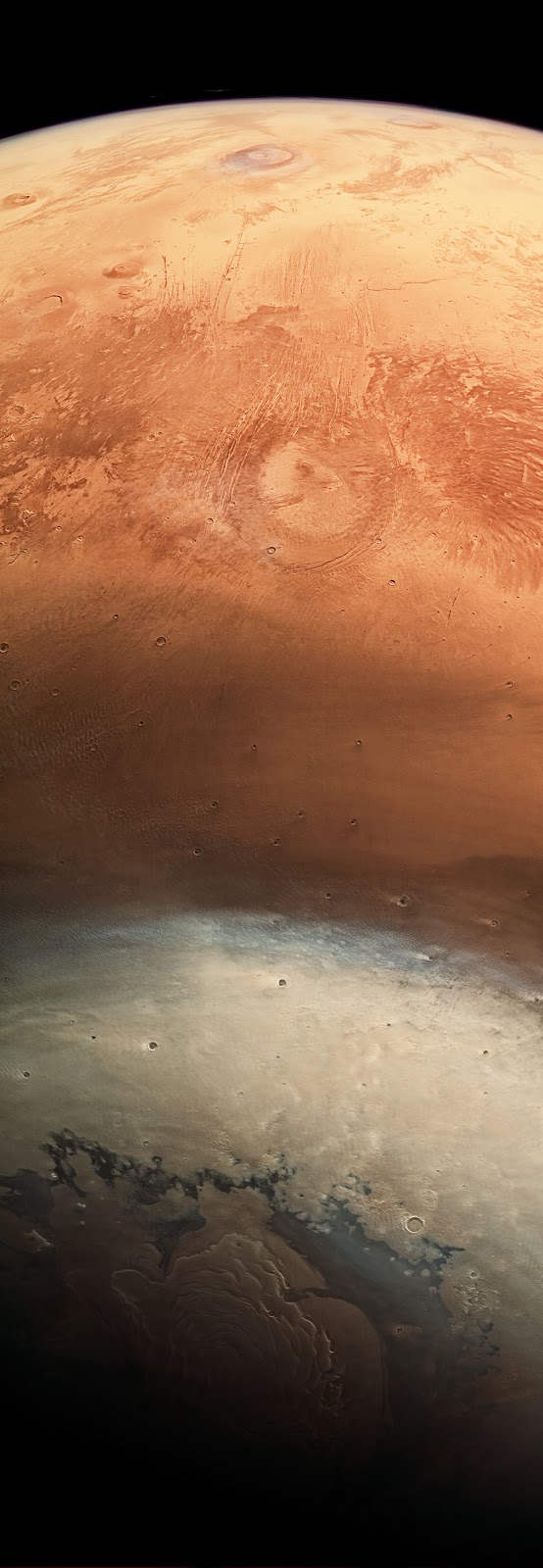ISS - Expedition 53 Mission patch.
Dec. 15, 2017
(Highlights: Week of November 27, 2017) - Last week aboard the International Space Station, crew members supported research in the fields of human health, plant science, physics and technology development.
Image above: NASA astronaut Randy Bresnik performs a blood draw as part of the MARROW investigation. Image Credit: NASA.
NASA astronaut Randy Bresnik removed the Long Duration Sorbent Testbed (LDST) locker from EXPRESS Rack 5 for its return on SpaceX-13. Exposure to space cabin environments can affect the performance of products designed to filter and clean air and water. LDST studies substances that collect other molecules, determining which types would be most effective on long-term missions to Mars or other destinations.
NASA astronaut Mark Vande Hei set up a new temperature monitor for the JAXA Protein Crystal Growth (JAXA PCG) investigation. This was necessary because the previous component stopped reporting data. JAXA Protein Crystal Growth produces high-quality protein crystals of biological macromolecules in microgravity. Detailed analysis of high quality protein crystal structures is useful in designing new pharmaceuticals and catalysts for a wide range of industries.
Image above: ESA astronaut Paolo Nespoli uses the Minus Eight Laboratory Freezer for ISS to store biological samples. Image Credit: NASA.
Bresnik and ESA (European Space Agency) astronaut Paolo Nespoli performed blood collections for the MARROW investigation. The samples were placed in the Minus Eighty Degree Celsius Laboratory Freezer for ISS (MELFI). Marrow looks at the effect of microgravity on bone marrow. It is believed that microgravity, like long-duration bedrest on Earth, has a negative effect on the bone marrow and the blood cells that are produced in the bone marrow.
NASA astronaut Joe Acaba prepared for the 5-day Advanced Plant Habitat Facility (Plant Habitat) checkout by installing power caps on the science carrier microcontroller, filling the water reservoir, and preparing the water refill bag and growth chamber. The crew also performed ten Plant Habitat acoustic measurement sets. The data from the measurements will be used to assess the environmental factors when the Plant Habitat facility is used in the JEM. Plant Habitat is a fully automated facility that will be used to conduct plant bioscience research on the orbiting laboratory. Plant Habitat compares differences in genetics, metabolism, photosynthesis, and gravity sensing between plants grown in space and on Earth in order to understand how microgravity changes plants.
Image above: Alexander Misurkin of Roscosmos and NASA astronaut Joe Acaba perform the SPHERES Zero Robotics investigation, which establishes an opportunity for high school students to design research for the International Space Station. Image Credit: NASA.
Acaba replaced the Additive Manufacturing Facility (Manufacturing Device) feedstock canister, extruder head, and print tray. The AMF uses an extrusion-based "3D printing" method, which enables the production of components on the station for both NASA and commercial objectives.
Other work was done on the following investigations: Payload Card Multilab-X, Rodent Research 6 (RR-6), CEO, Earth Imagery from ISS, Meteor, ISS Ham, Dream XM, One Strange Rock Virtual Reality, SPHERES Zero Robotics, Biochemical Profile, Circadian Rhythms, IPVI, Multi-Omics, NeuroMapping, Probiotics, Sarcolab-3, Space Headaches, ACME-CLD Flame, Two-Phase Flow, ZBOT, JEM Internal Ball Camera, NRCSD #13, Personal CO2 Monitor, PS-TEPC, Radi-N2.
International Space Station (ISS). Animation Credit: NASA
Related links:
Long Duration Sorbent Testbed (LDST): https://www.nasa.gov/mission_pages/station/research/experiments/explorer/Investigation.html?#id=1881
JAXA Protein Crystal Growth (JAXA PCG): https://www.nasa.gov/mission_pages/station/research/experiments/explorer/Investigation.html?#id=151
MARROW: https://www.nasa.gov/mission_pages/station/research/experiments/explorer/Investigation.html?#id=1673
Minus Eighty Degree Celsius Laboratory Freezer for ISS (MELFI): https://www.nasa.gov/mission_pages/station/research/experiments/explorer/Facility.html?#id=56
Advanced Plant Habitat Facility (Plant Habitat): https://www.nasa.gov/mission_pages/station/research/experiments/explorer/Facility.html?#id=2036
Additive Manufacturing Facility (Manufacturing Device): https://www.nasa.gov/mission_pages/station/research/experiments/explorer/Facility.html?#id=1934
Rodent Research 6 (RR-6): https://www.nasa.gov/mission_pages/station/research/experiments/explorer/Investigation.html?#id=7423
CEO: https://www.nasa.gov/mission_pages/station/research/experiments/explorer/Investigation.html?#id=84
Earth Imagery from ISS: https://www.nasa.gov/mission_pages/station/research/experiments/explorer/Investigation.html?#id=7565
Meteor: https://www.nasa.gov/mission_pages/station/research/experiments/explorer/Investigation.html?#id=1174
ISS Ham: https://www.nasa.gov/mission_pages/station/research/experiments/explorer/Investigation.html?#id=337
Dream XM: https://www.nasa.gov/mission_pages/station/research/experiments/explorer/Investigation.html?#id=7626
One Strange Rock Virtual Reality: https://www.nasa.gov/mission_pages/station/research/experiments/explorer/Investigation.html?#id=7598
SPHERES Zero Robotics: https://www.nasa.gov/mission_pages/station/research/experiments/explorer/Investigation.html?#id=679
Biochemical Profile: https://www.nasa.gov/mission_pages/station/research/experiments/explorer/Investigation.html?#id=980
Circadian Rhythms: https://www.nasa.gov/mission_pages/station/research/experiments/explorer/Investigation.html?#id=869
IPVI: https://www.nasa.gov/mission_pages/station/research/experiments/explorer/Investigation.html?#id=1690
Multi-Omics: https://www.nasa.gov/mission_pages/station/research/experiments/explorer/Investigation.html?#id=1689
NeuroMapping: https://www.nasa.gov/mission_pages/station/research/experiments/explorer/Investigation.html?#id=979
Probiotics: https://www.nasa.gov/mission_pages/station/research/experiments/explorer/Investigation.html?#id=2047
Sarcolab-3: https://www.nasa.gov/mission_pages/station/research/experiments/explorer/Investigation.html?#id=725
Space Headaches: https://www.nasa.gov/mission_pages/station/research/experiments/explorer/Investigation.html?#id=174
ACME-CLD Flame: https://www.nasa.gov/mission_pages/station/research/experiments/explorer/Investigation.html?#id=7564
Two-Phase Flow: https://www.nasa.gov/mission_pages/station/research/experiments/explorer/Investigation.html?#id=1034
ZBOT: https://www.nasa.gov/mission_pages/station/research/experiments/explorer/Investigation.html?#id=1135
JEM Internal Ball Camera: https://www.nasa.gov/mission_pages/station/research/experiments/explorer/Investigation.html?#id=7516
Personal CO2 Monitor: https://www.nasa.gov/mission_pages/station/research/experiments/explorer/Investigation.html?#id=1839
PS-TEPC: https://www.nasa.gov/mission_pages/station/research/experiments/explorer/Investigation.html?#id=1031
Radi-N2: https://www.nasa.gov/mission_pages/station/research/experiments/explorer/Investigation.html?#id=874
Space Station Research and Technology: https://www.nasa.gov/mission_pages/station/research/index.html
International Space Station (ISS): https://www.nasa.gov/mission_pages/station/main/index.html
Images (mentioned), Animation (mentioned), Text, Credits: NASA/Michael Johnson/John Love, Lead Increment Scientist Expeditions 53 & 54.
Best regards, Orbiter.ch












































